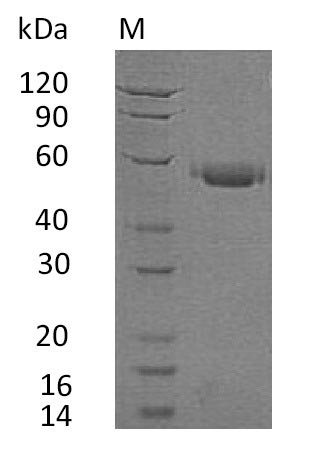Recombinant Human Tumor necrosis factor receptor superfamily member 5 (CD40) is produced in a mammalian expression system, which appears to provide high fidelity to native protein structures. The product consists of the extracellular domain (21-193aa) and is C-terminally Fc-tagged, ensuring stability and ease of detection. With a purity greater than 95% as confirmed by SDS-PAGE, this protein exhibits biological activity, measurable by its binding in a functional ELISA. The endotoxin level is controlled to be less than 1.0 EU/µg, as determined by the LAL method.
CD40 plays a critical role in the immune system. It's primarily known for mediating immune and inflammatory responses. As a member of the tumor necrosis factor receptor superfamily, CD40 is involved in various cellular processes, including B cell activation and regulation of immune responses. Its interactions and signaling pathways make it a significant focus in immunological research, particularly in studies related to immune regulation and potential therapeutic interventions.
Potential Applications
Note: The applications listed below are based on what we know about this protein's biological functions, published research, and experience from experts in the field. However, we haven't fully tested all of these applications ourselves yet. We'd recommend running some preliminary tests first to make sure they work for your specific research goals.
1. CD40-CD40L Binding Interaction Studies
This recombinant CD40 extracellular domain is confirmed to bind CD40L (ED₅₀ 0.45 μg/ml) and is suitable for interaction studies. However, the C-terminal Fc tag creates a dimeric protein that may not accurately mimic monomeric membrane-bound CD40's binding behavior. The measured affinity may reflect avidity effects from dimerization rather than true monomeric binding kinetics. Researchers should validate key findings with monomeric CD40 constructs for precise kinetic measurements.
2. Antibody Development and Characterization
The Fc-tagged CD40 serves as a good immunogen, but the Fc domain may dominate the immune response, reducing antibodies against CD40-specific epitopes. Antibodies generated may preferentially recognize the dimeric conformation rather than monomeric CD40. Comprehensive validation should include testing against monomeric, untagged CD40 to ensure recognition of physiological receptor forms.
3. Fc-Tag Mediated Pull-Down Assays
The Fc tag facilitates pull-down assays but may cause non-specific binding through Fc receptor interactions or protein A/G binding sites. While useful for initial screens, identified interactors should be validated with tag-free CD40. The dimeric nature may also capture complexes that monomeric CD40 would not, potentially identifying non-physiological interactions.
4. Functional ELISA Development
The protein is suitable for ELISA development, but the dimeric Fc-tagged format may affect antigen presentation compared to monomeric or membrane-bound CD40. Assays developed with this reagent may have different sensitivity and specificity profiles than those using monomeric CD40. The ED₅₀ should be re-established for each specific assay format.
5. Structural and Biophysical Characterization Studies
The Fc-tagged dimeric construct is problematic for structural studies as the large Fc domain (≈25 kDa) may impede crystallization of the CD40 extracellular domain (≈20 kDa). For meaningful structural biology, tag cleavage and isolation of the monomeric extracellular domain are recommended. The dimeric state may also not represent the physiological pre-ligand assembly state of CD40.
Final Recommendation & Action Plan
This mammalian-expressed human CD40 extracellular domain with C-terminal Fc tag is a functional reagent for binding studies and immunoassay development, but its dimeric nature (due to Fc tag) requires careful interpretation of results. For immediate use: 1) In binding studies, employ the ED₅₀ as a reference but acknowledge the avidity effects of dimerization; 2) For antibody development, use this protein for immunization but screen clones against monomeric CD40 to avoid dimer-specific antibodies; 3) In pull-down assays, include stringent controls for Fc-mediated non-specific binding; 4) For ELISA development, this dimeric protein may provide enhanced sensitivity but validate with clinical samples; 5) For structural work, remove the Fc tag prior to crystallization trials. The mammalian expression ensures proper glycosylation, which is important for CD40 function, but the dimeric configuration may not replicate the monomeric or trimeric states relevant to native CD40 signaling. Always include appropriate controls (e.g., Fc tag alone) and consider that different experimental systems may require monomeric CD40 for physiological relevance. For studies of CD40L binding and signal initiation, validate key findings with full-length membrane-bound CD40 in cellular contexts.




